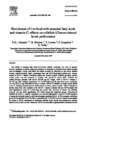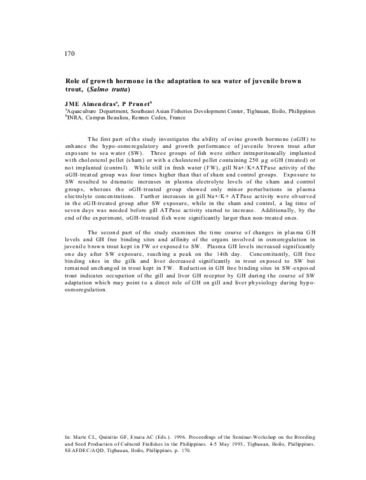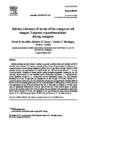| dc.contributor.author | Basiao, Zubaida U. | |
| dc.contributor.author | Eguia, Ruel V. | |
| dc.contributor.author | Doyle, Roger W. | |
| dc.date.accessioned | 2014-05-12T06:30:47Z | |
| dc.date.available | 2014-05-12T06:30:47Z | |
| dc.date.issued | 2005 | |
| dc.identifier.citation | Basiao, Z. U., Eguia, R. V., & Doyle, R. W. (2005). Growth response of Nile tilapia fry to salinity stress in the presence of an ‘internal reference’ fish. Aquaculture Research, 36(7), 712-720. | en |
| dc.identifier.issn | 1355-557X | |
| dc.identifier.uri | http://hdl.handle.net/10862/2028 | |
| dc.description.abstract | Growth of three strains of Oreochromis niloticus L. fry exposed to salinity stress in the presence of an internal reference fish were compared. The Central Luzon State University (CLSU) strain was obtained from the Freshwater Aquaculture Center, CLSU, Philippines. The ISRAEL strain was acquired from the Philippine government's Bureau of Fisheries and Aquatic Resources National Freshwater Fisheries Technology Center (BFAR-NFFTC), Munoz, Nueva Ecija. The National Inland Fisheries Institute (NIFI) strain was obtained from the NIFI, Bangkok, Thailand. Eight to nine full-sib families (replicates) per strain were split into two groups. One group was grown in freshwater for 2 weeks, acclimated to 32 ppt and reared for 2 weeks and finally grown in freshwater for another 2 weeks. Another group was contemporaneously grown in freshwater polyethylene tanks for 6 weeks. Each replicate family included a size-matched internal reference population of red tilapia strain. Two-way analysis of variance (anova) revealed no significant strain differences (P=0.081; r2=0.106). However, analysis of covariance with the internal reference strain used as a covariate showed significant (P=0.049; r2=0.638) strain effects on specific growth (based on standard length measurements). The ISRAEL strain showed consistently better growth rate in both saline and freshwater environments than the NIFI and CLSU strains. We estimated the statistical power of the two-way anova (ϕ=√(k′−1)(factor MS−s2)/(k′s>2); Zar 1984) to be ∼0.30. There was a 70% probability of a Type II error and no true difference in the growth of the three strains was detected. The use of internal reference strain as a covariate improved the r2 from 0.106 to 0.638 and increased the efficiency of the test in detecting a true difference. Other strain comparison studies in our laboratory at the Southeast Asian Fisheries Development Center Aquaculture Department showed that the ISRAEL strain shows better growth than the NIFI and CLSU strains in a crowding stress tolerance experiment, when fed only with rice bran and under restrictive feeding regimes. | en |
| dc.description.sponsorship | This work was made possible through financial support from the International Development Research Centre of Canada and the SEAFDEC. The authors thank A. Arago, B. Antazo and B. Banaag for their technical assistance. | en |
| dc.language.iso | en | en |
| dc.publisher | Blackwell Publishing | en |
| dc.subject | Oreochromis niloticus | en |
| dc.subject | Israel | en |
| dc.subject | Philippines, Luzon I., Nueva Ecija, Munoz | en |
| dc.subject | Thailand, Chacoengsao Prov., Bangkok | en |
| dc.subject | Internal reference | en |
| dc.title | Growth response of Nile tilapia fry to salinity stress in the presence of an ‘internal reference’ fish | en |
| dc.type | Article | en |
| dc.citation.volume | 36 | |
| dc.citation.issue | 7 | |
| dc.citation.spage | 712 | |
| dc.citation.epage | 720 | |
| dc.citation.journalTitle | Aquaculture Research | en |
| dc.subject.asfa | stress | en |
| dc.subject.asfa | biometrics | en |
| dc.subject.asfa | brackishwater fishes | en |
| dc.subject.asfa | feed composition | en |
| dc.subject.asfa | feeding behaviour | en |
| dc.subject.asfa | fish culture | en |
| dc.subject.asfa | fry | en |
| dc.subject.asfa | growth rate | en |
| dc.subject.asfa | inland fisheries | en |
| dc.subject.asfa | salinity effects | en |
| dc.subject.asfa | salinity tolerance | en |
| dc.subject.asfa | stocking density | en |
| dc.subject.asfa | tolerance | en |
| dc.subject.asfa | genetics | en |
| dc.subject.asfa | growth | en |
| dc.subject.asfa | salinity | en |
| dc.subject.asfa | strain | en |
| dc.identifier.essn | 1365-2109 | |
| dc.identifier.doi | 10.1111/j.1365-2109.2005.01283.x | |



